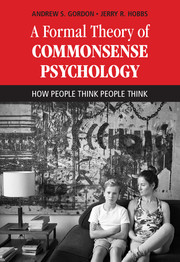Book contents
- Frontmatter
- Contents
- Part I Commonsense Psychology
- 1 Commonsense Psychology and Psychology page
- 2 Commonsense Psychology and Computers
- 3 Formalizing Commonsense Psychology
- 4 Commonsense Psychology and Language
- Part II Background Theories
- Part III Commonsense Psychology Theories
- Appendix A First-Order Logic
- References
- Index
2 - Commonsense Psychology and Computers
from Part I - Commonsense Psychology
Published online by Cambridge University Press: 01 September 2017
- Frontmatter
- Contents
- Part I Commonsense Psychology
- 1 Commonsense Psychology and Psychology page
- 2 Commonsense Psychology and Computers
- 3 Formalizing Commonsense Psychology
- 4 Commonsense Psychology and Language
- Part II Background Theories
- Part III Commonsense Psychology Theories
- Appendix A First-Order Logic
- References
- Index
Summary
ANTHROPOMORPHISM IS EASY AND FUN
Anthropomorphism is a human universal (Brown, 1991). That is, people in every culture naturally anthropomorphize nonhuman things. Like most other human universals with evolutionary utility, anthropomorphism is easy and fun. As every parent knows, contemporary first-world children experience an unending festival of anthropomorphism, where every fish, train, and lunar mass not only has a human face, but is also endowed with human emotions, human goals, and human reasoning abilities. Remarkably, children effortlessly cope with this massive amount of make-believe without too much trouble, and though they may desperately wish that their toys would come to life as they sometimes do in the movies, few seem particularly surprised that they do not.
While it is tempting to view anthropomorphism as simply a fanciful diversion of youth, the fish, trains, and moons that children treat as people are perhaps better viewed as training for the anthropomorphism that pervades the lives of adults. Playful attribution of human intellect to nonhuman physical objects continues as our toys become larger, where automobiles have preferences for high-octane gasoline and lawnmowers can be temperamental. More seriously, anthropomorphism becomes a tool for understanding the complexities of organizations. In adult anthropomorphism, governments easily acquire mental faculties, such that China can be concerned about its future petroleum needs and the United States can assign a higher priority to national security than to civil liberties. In many cases, this style of anthropomorphism is linguistic shorthand for references to the mental states of government officials, such as the concerns of members of the Chinese cabinet or the priorities of the US president. However, it is just as easy to talk about mental states of governments that are in reference to no one specifically among its citizenry, such as California's appetite for litigation.
Serious anthropomorphism by adults is best exemplified by the way that people treat corporations, each with its own corporate mission, values, institutional memories, business plans, and identity as a corporate citizen. As with governments, sometimes these terms are references to the people who direct the practices of the corporation.
- Type
- Chapter
- Information
- A Formal Theory of Commonsense PsychologyHow People Think People Think, pp. 17 - 35Publisher: Cambridge University PressPrint publication year: 2017

